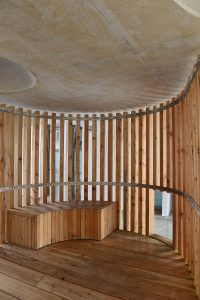Introduction
Playgrounds are more than just spaces for children to have fun and burn off energy; they are places where young minds can learn and appreciate the natural world. Building an environmentally friendly playground is not only an investment in the well-being of children but also a commitment to sustainability and ecological responsibility. Developing a playground is a fantastic opportunity to implement environmentally friendly practices and some simple initiatives can make a huge difference. In this comprehensive guide, we’ll explore the key principles and practical steps to design and construct an eco-friendly playground that benefits children, communities, and the planet.

Section 1: Planning for Eco-Friendly Playgrounds
1.1. Define Your Objectives
- Set clear objectives for the environmentally friendly playground. What are your goals? Consider aspects such as nature-based play, sustainability, and education.
1.2. Assess the Space
- Evaluate the available space for the playground, considering any geographical or environmental constraints. Work with existing planting and tree so they are effectively incorporated into the design.
1.3. Engage the Community
- Involve the local community, including children, parents, educators, and local authorities. Their input will help shape the design and ensure it meets the community’s needs.
Section 2: Sustainable Design Principles
 2.1. Natural Play Elements
2.1. Natural Play Elements
- Incorporate natural elements like rocks, water features, and native plants into the playground to create a connection with the environment. There’s often a big opportunity to plant trees on playgrounds. They offer shade, habitat and bring a calming feel to a space. Trees enhances our mood, reduces stress and improves our overall mental wellbeing. Greener spaces encourage more social interaction and a stronger sense of community. Trees help to improve soils, air quality, prevent flooding and erosion and absorb carbon dioxide from the atmosphere.
2.2. Reused, Recycled and Reclaimed Materials
- If the playground is an existing playground, consider refurbishing the playground equipment that’s already there. Painting older equipment is often a cheap, effective and environmentally friendly way of upgrading an existing playground. Utilise recycled and reclaimed materials for construction, such as reclaimed wood, recycled plastic, or rubber mulch. Choose new playground equipment that can either be recycled after time or made from biodegradable materials such as natural hardwoods. Try and stay away from any plastics.
2.3. Energy Efficiency
- Use energy-efficient LED lighting and consider solar-powered options for lighting or charging stations.
2.4. Rainwater Harvesting
- Implement rainwater harvesting systems to collect and reuse rainwater for irrigation or other purposes in the playground. Planting is a key component of a well-designed playground. If rainwater can be used stored for watering purposes, then you’re on to a winner. Better use of rainwater in years to come will be key to sustainability.
2.5. Accessible Design
- Ensure that the playground is accessible to all, including children with disabilities, by incorporating wheelchair accessible pathways and equipment. All of the above is recognised as the best route forward by Play England
Section 3: Sustainable Features and Equipment

3.1. Eco-Friendly Playground Equipment
- Choose playground equipment made from sustainable materials. FSC-certified hardwood such as oak or recycled metal are being used on more and more playground and the playground equipment industry becomes more environmentally conscious. These materials should be sourced as locally as possible to reduce the carbon footprint of transportation. Look for manufacturers committed to eco-friendly practices such as PlayEquip
3.2. Nature-Inspired Play Structures
- Chose playground equipment that mimics elements from the natural world, like treehouses, log balance beams, and boulder climbing walls.
3.3. Water Play
- Create water play areas using recirculating systems to minimise water waste. Incorporate natural materials like rocks and pebbles. These are often a big hit with smaller children.
3.4. Edible Gardens
- Include edible gardens where children can learn to grow and harvest their own fruits and vegetables, fostering a deeper connection with nature.
Section 4: Biodiversity and Wildlife
4.1. Native Plants and Habitats 
- Use native plants in landscaping to support local wildlife and promote biodiversity.
4.2. Wildlife-Friendly Design
- Design elements like birdhouses, ponds, butterfly gardens, or insect hotels to attract and support local wildlife.
4.3. Educational Signage
- Install educational signage to help children and visitors learn about the local flora and fauna grown on the playground.
Section 5: Sustainability Education
5.1. Incorporate Learning
- Design areas that facilitate environmental education, such as outdoor classrooms, interpretive signs, or interactive displays.
5.2. Nature-Based Curriculum
- Work with local schools to develop nature-based curriculum options that align with the playground’s eco-friendly theme.
Section 6: Maintenance and Care
6.1. Regular Inspections
- Schedule regular inspections to ensure safety, address maintenance needs, and monitor the sustainability features of the playground.
6.2. Community Involvement
- Encourage community members to participate in the upkeep of the playground, promoting a sense of ownership and stewardship. Adding planters to the design can encourage the local community to plant fruit, vegetables and herbs. Community gardens are a fantastic we of bringing the wider community together.

Conclusion
Creating an environmentally friendly playground is a visionary way to provide a space for children to play, learn, and appreciate the natural world. By following sustainable design principles, incorporating eco-friendly features, and fostering an educational environment, you can build a playground that not only benefits the immediate community but also contributes to a healthier and more sustainable planet. In doing so, you ensure that future generations will have access to playgrounds that are not just fun but also environmentally responsible.


 Playgrounds are essential for children’s physical and mental development, providing a safe and engaging environment for them to explore, socialise, and have fun. But what if you’re working with limited space? This is a common challenge particularly in an urban environment The good news is that even a small area can be transformed into a vibrant and exciting playground. In this guide, we’ll walk you through the steps to design a small playground that maximises fun and functionality.
Playgrounds are essential for children’s physical and mental development, providing a safe and engaging environment for them to explore, socialise, and have fun. But what if you’re working with limited space? This is a common challenge particularly in an urban environment The good news is that even a small area can be transformed into a vibrant and exciting playground. In this guide, we’ll walk you through the steps to design a small playground that maximises fun and functionality. Safety should always be a top priority, regardless of playground size. Ensure that the play area has proper surfacing, such as rubber mulch or safety tiles, to cushion falls. Appropriate fall zone also needs to be factored in. This is a key detail that is often overlooked. It’s important to involve a qualified playground inspector during the design process. This ensures that the designs are compliant with the standards of
Safety should always be a top priority, regardless of playground size. Ensure that the play area has proper surfacing, such as rubber mulch or safety tiles, to cushion falls. Appropriate fall zone also needs to be factored in. This is a key detail that is often overlooked. It’s important to involve a qualified playground inspector during the design process. This ensures that the designs are compliant with the standards of 
 Designing a school playground is not a one-person job. Involving the school community, including specialist designers, independent play inspector, students, parents, teachers, and administrators, can lead to a more inclusive and successful design. Conduct surveys, hold meetings, and gather input to ensure that the playground meets the needs and preferences of everyone involved.
Designing a school playground is not a one-person job. Involving the school community, including specialist designers, independent play inspector, students, parents, teachers, and administrators, can lead to a more inclusive and successful design. Conduct surveys, hold meetings, and gather input to ensure that the playground meets the needs and preferences of everyone involved. A well-organised playground should have different zones or divisions to cater to various age groups and activities. Consider dividing the playground into areas for younger children, older children, and potentially separate areas for specific activities such as sports, art, reading, physical play, or gardening. This division helps prevent conflicts and ensures that each group has access to age-appropriate equipment and activities.
A well-organised playground should have different zones or divisions to cater to various age groups and activities. Consider dividing the playground into areas for younger children, older children, and potentially separate areas for specific activities such as sports, art, reading, physical play, or gardening. This division helps prevent conflicts and ensures that each group has access to age-appropriate equipment and activities. Selecting the right
Selecting the right  Encourage physical fitness by incorporating elements that challenge children’s physical abilities. This can include:
Encourage physical fitness by incorporating elements that challenge children’s physical abilities. This can include:

















 l play. This would provide opportunities for grandparents and parents to play with their children, creating a more inclusive and multi-generational community. Again, since the pandemic we have had many more requests for mix use play areas. Our designs often extend into
l play. This would provide opportunities for grandparents and parents to play with their children, creating a more inclusive and multi-generational community. Again, since the pandemic we have had many more requests for mix use play areas. Our designs often extend into 




